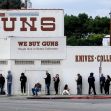“It shall be unlawful for any person who has been convicted in any court of, a crime punishable by imprisonment for a term exceeding one year…to…possess…any firearm…” - Unlawful Acts, 18 U.S Code §922 (g) (1)
But should it be? Stuart Duarte, a man with five California criminal convictions, all non-violent and all punishable by more than one year, challenged the Unlawful Acts section of the U.S. Code cited above, arguing that his constitutional rights had been violated. The Ninth Circuit ruled on May 9 that Duarte, even though an ex-felon, is still a person, and thus the application of 18 U.S. Code §922 (g) (1) is unlawful under the Second Amendment.
Writing for the Ninth Circuit, Justice Carlos T. Bea concluded the court must vacate Duarte’s conviction and reverse the ruling of Judge Andre Birotte of the United States District Court for the Central District of California. This new Ninth Circuit 2-1 ruling by Bea, with a concurrence by Circuit Justice Lawrence VanDyke and a dissent by Milan D. Smith Jr., follows the 2022 decision by the U.S. Supreme Court in New York State Rifle & Pistol Ass’n v. Bruen, 597 U.S. 1 (2022). Bruen held that “New York's proper-cause requirement violates the Fourteenth Amendment by preventing law-abiding citizens with ordinary self-defense needs from exercising their Second Amendment right to keep and bear arms in public for self-defense.”
The government had argued in Duarte’s case that the Ninth Circuit’s previous ruling in United States v. Vongxay, which came before Bruen, prevented Duarte’s challenge. Therefore, the Ninth Circuit recognized the need for it to reconsider the Unlawful Acts section of the U.S. Code by applying Bruen’s new “two-step, text-and-history framework “
Bea began the Ninth Circuit opinion with a review of the facts. On the night of March 20, 2022, two Inglewood, California, police officers saw a red Infiniti run a stop sign. They followed the car and saw Duarte throw a gun out the window. They followed Duarte, handcuffed him and the other passengers, and searched their car, finding the magazine that exactly fit the tossed handgun. A federal Grand Jury convicted Duarte of illegally possessing a firearm in violation of 18 U.S Code §922 (g) (1). He pleaded not guilty to charges of possessing a firearm and evading a police officer. He was sentenced to 51 months in prison and appealed.
The Ninth Circuit opinion then explained that Duarte’s case would be reviewed under a “good cause” standard, rather than a plain-error one, because Duarte’s Second Amendment defense was not raised until his appeal. This was necessary because Bruen had not yet been decided and Vongxay had already ruled that “§922(g) (1) does not violate the Second Amendment as it applies to . . . convicted felon, and thus it is “clearly irreconcilable with Bruen.”
Bea then explained the “two-step’ framework for analyzing Second Amendment challenges” prior to Bruen. Then, he quickly said that post-Bruen, the “traditional analysis tiers-of-scrutiny” framework was to be replaced by one “grounded exclusively in text and history.” The Bruen analysis begins with the “threshold question of whether the Second Amendment covers the individual, the type of arm and the proposed course of conduct.” After review, the Ninth Circuit concluded that the Second Amendment protects handguns and that, since Duarte is “an American citizen, he is “part of ‘the people’ whom the Second Amendment protects.” Bea provided a lengthy history of the Second Amendment rights of all citizens and concluded, “…the right to bear arms was publicly understood as the fundamental right of every citizen.”
He continued to review compliance with Step Two by concluding that the government “failed to prove that § 922(g)(1)’s categorical prohibition, as applied to Duarte, “is part of the historical tradition that delimits the outer bounds of the Second Amendment right.” The government, Bea wrote, did not introduce evidence of a “representative historical analogue that imposed a comparable burden on the right of armed self-defense” that could compare to the “sweeping, no-exception, lifelong ban” imposed by the U.S. Code. He also rejected the Government’s analogies that compared 18 U.S Code §922 (g) (1) to historical examples including laws that disarmed “British loyalists” after the Revolutionary War, a law from the 1700s that removed weapons from Papists in several colonies, laws that took guns away from Native Americans (referred to in the opinion as “Indians”), and laws prohibiting slaves and free Blacks from owning or possessing firearms.
Regarding historical precedent, Bea concluded, “In sum, the burdens and justifications (Bruen’s “how”
and “why”) for laws disarming disfavored groups at the Founding are not “distinctly similar” to
§922(g) (1) to justify its blanket ban on non-violent felons possessing firearms. “Courts should not uphold every modern law that remotely resembles a historical analogue because doing so risk endorsing outliers that our ancestors would never have accepted.”
Bea next provided additional arguments against the Government’s position that 18 U.S Code §922 (g) (1) is lawful. First, he said, “the history of punishing felonies at the Founding is far more nuanced than the Government lets on; the notion that all felons (violent and non-violent alike) were historically put to death or stripped of their estates is “shaky” to begin with.” He also pointed out that “today’s felon, in many respects, resembles nothing of his Founding-era counterpart, despite bearing the same label. He also noted that the Government’s analogies “expand” the historical felony category “far too broadly” and in order to be fair, they must be “distinctly similar.”
Dissenting Justice Smith said he “hoped our court will rehear the case en banc to correct the majority’s misinterpretation of Bruen.
In summary and conclusion, the published Ninth Circuit opinion said, “We do not base our decision on the notion that felons should not be prohibited from possessing firearms. As a matter of policy, §922(g) (1) may make a great deal of sense. But the very enumeration of the right” in our Constitution “takes out of hands . . . the power to decide” for which Americans “that right is really worth insisting upon.” He continued, “Duarte is an American citizen, and thus one of “the people” whom the Second Amendment protects. The Second Amendment’s plain text and historically understood meaning therefore presumptively guarantee his individual right to possess a firearm for self-defense. The Government failed to rebut that presumption by demonstrating that permanently depriving Duarte of this fundamental right is otherwise consistent with our Nation’s history.
We therefore hold that § 922(g) (1) violates Duarte’s Second Amendment rights and is unconstitutional as applied to him.”






